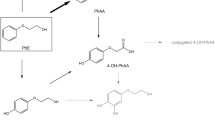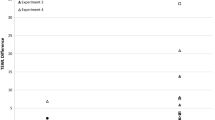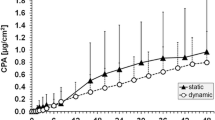Abstract
Objectives: The aims of the study were threefold: to assess the skin uptake of the industrial catalyst dimethylethylamine (DMEA) (a) in vitro from water solutions by fresh guinea-pig and human skin specimens, (b) in gaseous form in vivo in human volunteers, and (c)␣to estimate the relevance of the uptake as an occupational hazard.
Methods: Specimens from the in vitro and in vivo experiments were analysed by gas chromatography using a nitrogen-sensitive detector.
Design: DMEA, diluted with water or isotonic saline solution was applied to fresh human or guinea-pig skin, mounted in Teflon flow-through cells with a perfusion fluid flow rate of 1.5 ml/h, samples being collected at 2-h intervals for 48 h. Three healthy male volunteers each had their right forearm exposed (in a Plexiglass chamber) for 4 h to DMEA at each of three different levels (250, 500 and 1000 mg/m3 air). Urine was collected up to 24 h after the start of each experiment.
Results: DMEA penetrated both guinea-pig and human skin. The median steady-state flux and permeability coefficient (K p) values, were 0.009 mg/cm2 × h and 0.001 cm/h, respectively, for guinea-pig skin, and 0.017 mg/cm2 × h and 0.003 cm/h, respectively, for human skin. The median uptake in the three volunteers at the different DMEA exposure levels (250, 500 or 1000 mg/m3) was 44, 64 and 88 μg, respectively. The median K p for all experiments was 0.037 cm/h.
Conclusion: Uptake of DMEA through the skin is of far less importance than simultaneous uptake via the airways. Thus, the amount of DMEA excreted in urine is a variable of limited use for the purposes of biological monitoring. Although a wide range of K p values was obtained in the in vitro experiments, both for guinea-pig and human skin, there was no marked difference in median K p values between the two types of skin. The K p values were lower than those obtained for human forearm skin in vivo. However, future studies of other tertiary aliphatic amines may show the in vitro␣method to yield values predictive of those obtained in in vivo studies.
Similar content being viewed by others
Author information
Authors and Affiliations
Additional information
Received: 20 May 1996 / Accepted: 10 March 1997
Rights and permissions
About this article
Cite this article
Lundh, T., Boman, A. & Åkesson, B. Skin absorption of the industrial catalyst dimethylethylamine in vitro in guinea pig and human skin, and of gaseous dimethylethylamine in human volunteers. Int Arch Occup Environ Health 70, 309–313 (1997). https://doi.org/10.1007/s004200050223
Issue Date:
DOI: https://doi.org/10.1007/s004200050223




